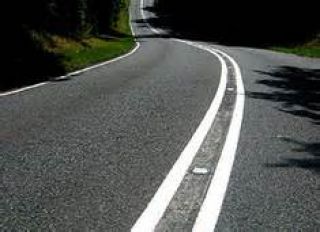

Two solid lines painted on the pavement guide traffic away from fixed objects such as bridge piers or concrete islands. A double white line indicates that lane changes are prohibited. Pedestrian crossovers are marked by two white double parallel lines across the road with an X in each lane approaching it.ĭrivers and cyclists must stop before the line and yield to pedestrians until pedestrians have completely crossed the road and cleared the roadway. White lines separate lanes for which travel is in the same direction. White lines on both sides of road These solid white lines running along the edge of the road indicate the shoulder of the road and let you know that if the line is on your right side you’re. Pedestrian crossovers are identified by specific signs, overhead yellow lights, and pavement markings. If there is no sidewalk, stop at the edge of the intersection.Ī white arrow painted on a lane means you may move only in the direction of the arrow. The lines may be solid or broken (long dashes), single or double. If there is no crosswalk, stop at the edge of the sidewalk. White and yellow lines are used on pavement edges and between lanes to keep vehicles in line. If there is no stop line, stop at the crosswalk. However, crosswalks at intersections are not always marked. If there is no sidewalk, stop at the edge of the intersection.Ī crosswalk is marked by two parallel white lines painted across the road. If there is no crosswalk, stop at the edge of the sidewalk. Explanation White lines between lanes of traffic indicate that traffic is moving in the same direction, and solid lines between lanes of traffic means passing is not permitted. If there is no stop line marked on the road, stop at the crosswalk, marked or not. When may you cross a double solid white line in the middle of the road A: To pass traffic thats queuing back at a junction B: To pass a car signalling to.

Continuity lines on your right mean your lane will continue unaffected.Ī stop line is a single white line painted across the road at an intersection. When you see continuity lines on your left side, it generally means the lane you are in is ending or exiting and that you must change lanes if you want to continue in your current direction. ('A' may pass if there are enough broken lines ahead to complete the pass safely.)īroken lines that are wider and closer together than regular broken lines are called continuity lines. ('A' should not pass.)Ī broken line at the left of your lane means you may pass if the way is clear. White lines separate traffic travelling in the same direction.Ī solid line at the left of your lane means it is unsafe to pass.
#Double solid white line manual
Yellow lines separate traffic travelling in opposite directions. Answer (1 of 2): I’ve said it before and I’ll note it again, get a little US government pamphlet called The Manual of Uniform Traffic Control Devices (MUTCD).

#Double solid white line code
Pavement markings divide traffic lanes, show turning lanes, mark pedestrian crossings, indicate obstacles and tell you when it is not safe to pass. Vehicle Code 21460 is the California statute that makes it a crime for a motorist to cross double yellow parallel lines on State roadways. 13) Mixed double lane divider/solid yellow with broken yellow or white line. Loading/unloading, disabled blue badge holders and other exceptions. The Mersey Tunnels of course have a by-law that prohibits lane changes.Pavement markings combine with road signs and traffic lights to give you important information about the direction of traffic and where you may and may not travel. Double yellow lines Penalty Charge Notice (PCN) fines. Over here, strictly speaking the double whites should only be used where visibility is poor and you can't see oncoming traffic which devalues the line in a straight tunnel with decent forward visibility. Interestingly, in France they usually only ban lane changes by lorries: Or maybe it has double solid yellow lines, sometimes with a black line between them. You may find yourself on a seemingly quiet, empty road, but it still has a solid double white line. It prevents side swipes from either lane.

That is a good point - to my mind overtaking is changing lanes, passing a vehicle, and changing back to the original lane. These solid white lines transition into dotted lines at the exact point of exit or entry. You would also need the order to go with them too If the unbroken line is only on your side. Is it technically overtaking on a dual carriageway though ? :-/ I dunno if most of the motoring public would get the concept on what they see as s one way tunnel. Dividing lines Double white unbroken (continuous) lines mean you are not allowed to overtake in either direction. Bryn666 wrote:The correct way (in accordance with TSRGD) would be to use regular hazard lines with "No Overtaking" signs at regular intervals.


 0 kommentar(er)
0 kommentar(er)
